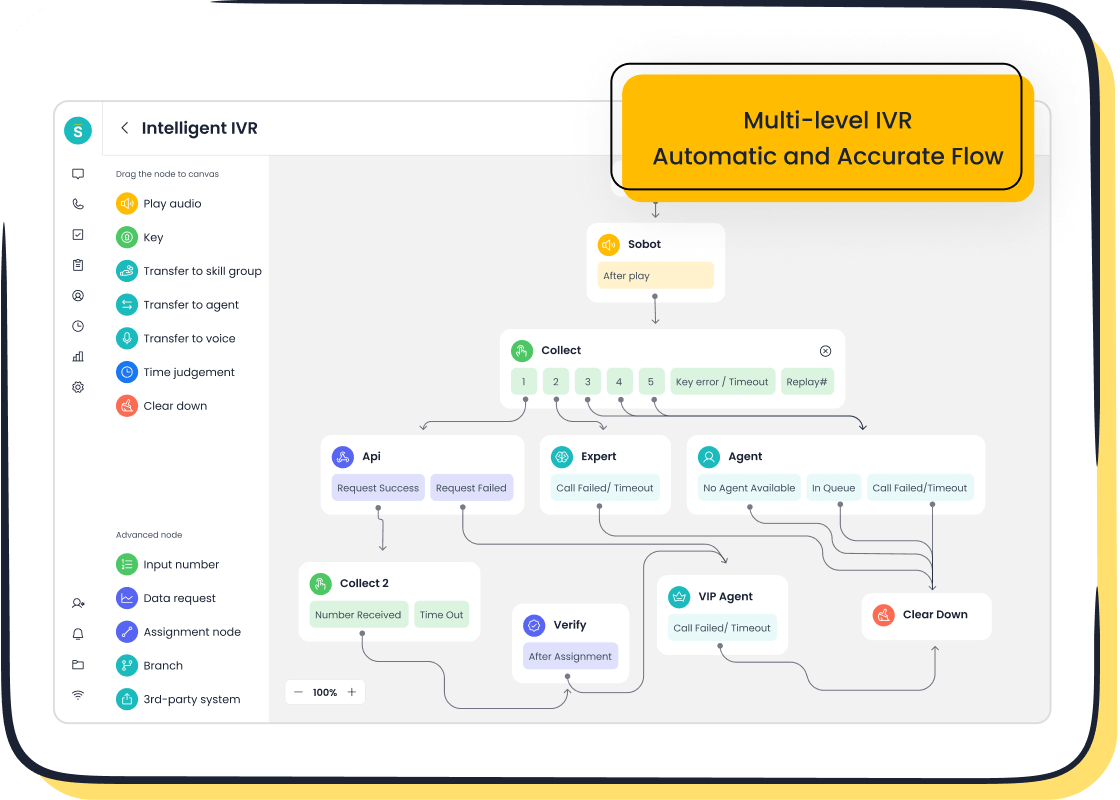The Ultimate Guide to Better Customer Support Skills

Imagine walking into a store where every employee knows exactly how to help you, listens carefully, and resolves your concerns quickly. That’s the magic of great customer service. It’s not just about solving problems; it’s about creating a customer experience that feels personal and effortless. When you sharpen your customer support skills, you’re not just helping customers—you’re building loyalty, trust, and long-term success for your business.
Continuous learning plays a huge role here. Teams that embrace learning cultures often achieve customer satisfaction scores 30% higher than their competitors. Why? Because staying updated with new tools and techniques helps you deliver faster solutions, adapt to changes, and even anticipate customer needs. Tools like Sobot’s advanced solutions make it easier to integrate technology into your workflows, boosting efficiency while improving service quality.
With the right mix of skills, learning, and technology, you can turn every interaction into a win—for both you and your customers.
Understanding the Foundations of Customer Support Skills
The Role of Empathy in Building Customer Trust
Empathy is the heart of great customer service. When you genuinely understand and acknowledge a customer’s feelings, you create a connection that builds trust. This trust isn’t just a feel-good factor—it’s a business asset. Studies show that empathy fosters stronger relationships, leading to increased customer loyalty and repeat business. Think about it: when a customer feels heard and valued, they’re more likely to return and recommend your service to others.
Empathy also reduces stress and anxiety for customers. Imagine calling support when you’re already frustrated, and the agent responds with kindness and understanding. That simple act can turn a negative experience into a positive one. By practicing empathy, you not only solve problems but also enhance the overall customer experience.
Active Listening as a Cornerstone of Effective Communication
Active listening is more than just hearing words—it’s about understanding the message behind them. When you listen actively, you show customers that their concerns matter. This builds trust and engagement, making them feel valued. It also helps you gather authentic feedback, which can guide improvements in your service.
Active listening involves paying attention to tone and context. For example, a calm tone can reassure a frustrated customer, while mindful listening ensures you fully grasp their needs. Studies highlight that listening to customers improves satisfaction and helps meet their expectations. By focusing on what they’re saying, you can provide better solutions and create a more meaningful interaction.
Clear and Professional Communication Standards in Customer Service
Clear communication is the backbone of effective customer service. When you explain solutions in a simple and professional way, customers feel confident and informed. Poor communication, on the other hand, can lead to misunderstandings and frustration. A 2023 report revealed that unclear communication increases employee stress by 7% and reduces productivity by 15%. Imagine the impact this could have on your customers.
Metrics like handling time and first-call resolution rates show how well your team communicates. When you resolve issues quickly and clearly, you boost customer satisfaction and build trust. Setting professional communication standards ensures your team delivers consistent, high-quality service every time.
Practical Tips to Improve Customer Service Skills

Mastering Product Knowledge to Address Customer Needs
Knowing your product inside and out is one of the most powerful ways to improve customer service. When you understand customer needs and can confidently explain how your product solves their problems, you build trust and credibility. Customers appreciate when you can answer their questions without hesitation or redirecting them multiple times.
Mastering product knowledge doesn’t just help you answer questions—it also allows you to anticipate concerns before they arise. For example, if a customer asks about compatibility, you can proactively offer solutions or alternatives. This kind of expertise makes interactions smoother and enhances the overall customer experience.
Metrics like Net Promoter Score (NPS) and Customer Effort Score (CES) show how product knowledge impacts customer satisfaction. Here’s a quick breakdown:
| Metric | Description | Importance |
|---|---|---|
| Net Promoter Score (NPS) | Measures customers' willingness to recommend products/services. | Indicates customer satisfaction, loyalty, and advocacy. A high score suggests strong product value. |
| Customer Health Score | Aggregates customer-level data for overall satisfaction view. | Predicts churn and identifies at-risk customers, indicating overall customer well-being. |
| Customer Effort Score (CES) | Assesses the effort required by customers to resolve issues or fulfill requests. | Lower effort correlates with higher satisfaction, reflecting usability and service efficiency. |
| Qualitative Customer Feedback | Non-numerical feedback providing insights into customer experiences. | Offers in-depth understanding of customer needs and perceptions, highlighting potential issues. |
Sobot’s Voice/Call Center solution is a great example of how product knowledge can be leveraged effectively. With features like intelligent IVR and AI-powered Voicebot, agents can quickly address customer inquiries and provide tailored solutions, improving first-contact resolution rates.
Developing Technical Skills for Efficient Problem-Solving
Technical skills are the backbone of efficient problem-solving in customer service. When you know how to navigate systems, troubleshoot issues, and use tools effectively, you can resolve customer concerns faster. This reduces frustration for both you and the customer.
Practical training plays a huge role here. Employees who receive technical training are better equipped to handle challenges and often contribute innovative solutions. For instance:
- Practical skills training enhances employee capabilities and performance.
- Problem-solving skills are essential for overcoming work obstacles.
- Employees with strong practical skills are more likely to engage in innovative problem-solving and contribute positively to their work environment.
Sobot’s Omnichannel Solution simplifies technical workflows for customer service teams. Its unified workspace consolidates customer data, making it easier for agents to access information and resolve issues efficiently. By integrating AI-driven automation, repetitive tasks are handled seamlessly, freeing up agents to focus on complex problems.
Using Positive Language to Enhance Customer Interactions
Words matter. The way you communicate can make or break a customer interaction. Using positive language helps you create a welcoming and reassuring tone, even when delivering bad news. For example, instead of saying, “We can’t do that,” you could say, “Here’s what we can do to help.”
Positive interactions aren’t just about being polite—they directly impact customer loyalty and satisfaction. Consider these industry benchmarks:
- 54% of customers would stop purchasing from a brand after just one bad experience, highlighting the importance of positive interactions.
- Repeat customers generate 300% more revenue than first-time shoppers, indicating that positive experiences lead to increased customer loyalty and sales.
Sobot’s AI-powered Chatbot is a great tool for maintaining positive communication. It uses natural language processing to ensure responses are friendly and helpful, creating a seamless customer experience. By automating repetitive queries, it also allows agents to focus on delivering personalized and empathetic service.
Team and Organizational Strategies to Invest in Customer Service Training
Designing Comprehensive Training Programs for Teams
A well-designed training program is the backbone of a successful customer service team. When you invest in customer service training, you empower your team to handle challenges confidently and deliver exceptional experiences. Comprehensive programs should focus on both technical skills and soft skills like empathy and communication.
Research shows that businesses prioritizing customer experience grow revenue 1.7 times faster than their competitors. Additionally, retaining customers is 5-7 times more cost-effective than acquiring new ones. These stats highlight the importance of equipping your team with the tools and knowledge to understand customer needs and foster loyalty.
Here’s a quick look at the impact of training investments:
| Company | Investment | Employee Engagement | Customer Satisfaction | Retention Rate | ROI |
|---|---|---|---|---|---|
| Tech Startup | $75,000 | 65% to 90% | N/A | 20% to 12% | $4.53 |
| Walmart | $50 million/year | N/A | 30% increase | 10% increase | N/A |
| Innovative Solutions | N/A | N/A | N/A | 85% | N/A |
By designing training programs that address real-world scenarios, you can prepare your team to respond quickly and effectively, boosting customer satisfaction and loyalty.
Building a Feedback-Driven Culture for Continuous Improvement
Feedback is a goldmine for improving customer service. Actively collecting and analyzing feedback helps you identify areas where your team can improve. It also shows customers that you value their opinions, which strengthens trust and loyalty.
To build a feedback-driven culture, start by encouraging open communication within your team. Use customer feedback to guide training sessions and refine processes. For example:
- Analyze feedback to uncover recurring issues.
- Implement changes based on actionable insights.
- Create a system for tracking improvements over time.
When you make feedback a priority, you’ll see a noticeable improvement in customer satisfaction and team performance.
Encouraging Collaboration and Knowledge Sharing Among Teams
Collaboration is key to innovation in customer service. When your team shares knowledge, they learn from each other’s experiences and develop creative solutions to challenges. This not only improves individual performance but also enhances the overall customer experience.
Here are some practical ways to foster collaboration:
- Add knowledge sharing to your onboarding process.
- Start team meetings with a “knowledge-sharing moment.”
- Host problem-solving workshops and cross-training sessions.
- Encourage leadership to share insights during “office hours.”
Research shows that effective knowledge sharing boosts innovation and productivity. By creating a culture of collaboration, you’ll empower your team to deliver consistent, high-quality service.
Leveraging Technology and Tools to Improve Customer Service

Enhancing Support with Sobot’s Voice/Call Center Solutions

Technology has transformed how you can deliver exceptional customer service. One of the most effective tools is Sobot’s Voice/Call Center solution. It’s designed to simplify communication and improve efficiency, making it easier for your team to handle customer inquiries. With features like intelligent IVR and AI-powered Voicebot, you can route calls smartly and resolve issues faster. This means less waiting time for customers and more productive agents.
The numbers speak for themselves. Businesses using Sobot’s Voice/Call Center have seen a 30% increase in agent efficiency and a 97% customer satisfaction score. These metrics highlight how the right tools can elevate your service quality. Imagine being able to track and analyze call data in real time or automate bulk outbound tasks. These capabilities not only save time but also ensure that every customer interaction feels seamless and professional.
If you’re looking to improve customer service, integrating a solution like this can make a world of difference. It’s not just about solving problems—it’s about creating a smooth and satisfying customer experience.
Using AI and Automation to Streamline Customer Interactions
AI and automation are game-changers in customer service. They help you handle repetitive tasks, freeing up your team to focus on more complex issues. For example, Sobot’s AI-powered Chatbot can answer common questions 24/7, ensuring customers get quick responses even outside business hours. This kind of efficiency boosts customer satisfaction and reduces operational costs.
The impact of AI is undeniable. Studies show that 73% of shoppers believe AI improves their experience, and 80% of customers report positive interactions with AI-powered tools. By 2025, it’s projected that 95% of customer interactions will be powered by AI. These stats underline the growing importance of automation in delivering fast and reliable service.
Sobot’s Omnichannel Solution takes automation a step further by integrating AI across multiple platforms. Whether it’s email, social media, or live chat, you can provide consistent and personalized support. This not only improves customer service but also strengthens relationships with your audience.
Optimizing Customer Databases for Personalized Experiences
Personalization is the key to winning customer loyalty. When you optimize your customer databases, you gain valuable insights into their preferences and behaviors. This allows you to tailor your services and create experiences that feel uniquely crafted for each individual.
Did you know that 83% of consumers are willing to share their data for personalized experiences? This highlights how much customers value tailored interactions. Optimized databases lead to improved satisfaction, higher retention rates, and stronger relationships. For instance, by analyzing customer data, you can identify trends and proactively address potential issues.
Sobot’s unified workspace consolidates customer information, making it easier for your team to access relevant data during interactions. This ensures that every conversation feels personal and informed. When you combine this with tools like Sobot’s Voice/Call Center, you can deliver a level of service that not only meets but exceeds expectations.
Measuring and Continuously Improving Customer Support Performance
Analyzing Customer Feedback for Actionable Insights
Customer feedback is like a treasure chest of insights waiting to be unlocked. To improve customer service, you need to capture customer feedback and turn it into actionable steps. But how do you do that effectively? By combining quantitative and qualitative methods.
Quantitative data, like survey results, helps you identify patterns and trends. For example, you can measure satisfaction levels or track how often customers face specific issues. On the other hand, qualitative data dives deeper into customer concerns. Interviews and focus groups reveal what customers truly think about their experience.
“Qualitative research methods such as user interviews and focus groups allow you to explore how users interact with your product, revealing issues that might not be captured through quantitative data alone.”
By blending these approaches, you get a complete picture of what’s working and what needs improvement. For instance, surveys can highlight a drop in satisfaction, while interviews explain why it’s happening. This dual approach ensures you’re not just guessing but making informed decisions to enhance the customer experience.
Conducting Regular Performance Reviews to Identify Gaps
Performance reviews aren’t just for employees—they’re essential for your customer service strategy too. Regularly reviewing metrics like response times and resolution rates helps you spot gaps in your processes.
Here’s a quick look at some key performance indicators (KPIs) you can track:
| KPI Name | Description |
|---|---|
| Customer Satisfaction Score (CSAT) | Measures customer satisfaction out of 100. |
| Net Promoter Score (NPS) | Measures customer’s desire to promote your business. |
| Customer Effort Score (CES) | Measures how difficult it is for a customer to do business. |
| Time to Resolution (TTR) | Measures the time it takes to resolve a customer support ticket. |
| First Contact Resolution (FCR) | Measures the proportion of first responses that solve tickets. |
Tracking these KPIs helps you analyse customer concerns and identify areas where your team can improve. For example, if your First Response Time (FRT) is high, it might mean your team needs better tools or training. Regular reviews ensure you’re always moving toward better service.
Setting Measurable Goals to Drive Skill Development
Setting measurable goals is like giving your team a roadmap to success. Without clear targets, it’s hard to know if you’re improving. Start by benchmarking your current performance. Use internal benchmarks to compare against past results and external benchmarks to see how you stack up against industry standards.
| Benchmark Type | Description |
|---|---|
| Internal Benchmarking | Evaluating past performance to set realistic future goals based on previous attempts. |
| External Benchmarking | Comparing metrics like Customer Satisfaction and Net Promoter Scores to industry standards. |
For example, if your Net Promoter Score (NPS) is below the industry average, set a goal to improve it by 10% over the next quarter. Break this down into actionable steps, like training your team on empathy or adopting tools like Sobot’s Voice/Call Center to streamline workflows.
When you set clear, measurable goals, you give your team something to aim for. This not only boosts motivation but also ensures continuous improvement in customer service skills.
Mastering customer support skills isn’t just about solving problems—it’s about creating experiences that delight your customers and keep them coming back. Tools like Sobot’s Voice/Call Center make this easier by streamlining workflows and improving efficiency. The results speak for themselves: 74% of companies see a direct link between great service and financial success, while 76% report higher customer retention rates. By investing in training and adopting advanced technologies, you can build stronger relationships and drive long-term growth. Remember, continuous improvement is the secret to staying ahead.
FAQ
What are the most important skills for customer support agents?
Empathy, active listening, and clear communication are essential. These skills help you connect with customers, understand their concerns, and provide effective solutions. Mastering product knowledge and technical skills also ensures you can address issues confidently and efficiently.
How can Sobot’s tools improve my customer service?
Sobot’s solutions, like the Voice/Call Center and Omnichannel platform, streamline workflows and automate repetitive tasks. They help you respond faster, personalize interactions, and improve first-contact resolution rates. This boosts customer satisfaction and team productivity.
Why is customer feedback so important?
Feedback shows you what’s working and what needs improvement. It helps you refine your processes, train your team, and enhance the customer experience. Plus, customers feel valued when you act on their suggestions, which builds trust and loyalty.
How do I measure the success of my customer support efforts?
Track metrics like Customer Satisfaction Score (CSAT), Net Promoter Score (NPS), and First Contact Resolution (FCR). These KPIs reveal how well you’re meeting customer expectations and where you can improve.
Can AI really make customer service better?
Absolutely! AI tools like Sobot’s Chatbot handle repetitive queries 24/7, freeing your team to focus on complex issues. They also provide quick, accurate responses, improving customer satisfaction and reducing wait times.
See Also
Enhancing Customer Satisfaction Through Effective Live Chat Strategies
Achieving Excellence in Customer Support via Live Chat
Transforming Customer Support with AI-Powered Service Agents
Selecting the Right Social Media Tools for Customer Service
Effective Management Strategies for Live Chat Support Agents